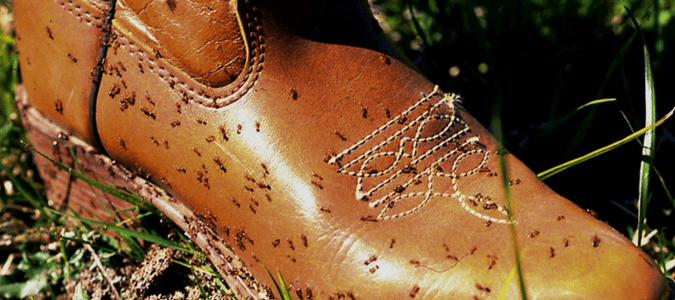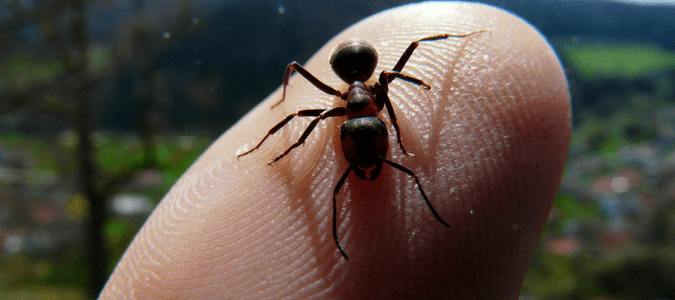
For such a tiny creature, ants have quite an impact on humans. These insects have lived on Earth for over 100 million years, outlasting the dinosaurs. As social animals, ants live in groups that can number in the millions. Although ants perform an important function in nature, bites from these pests can be annoying, painful and can even trigger a life-threatening allergic reaction in some individuals.
To help better understand how to treat an ant bite, it’s helpful to know about the different types of ants you might encounter and what attracts them to your home. Once you have treated your ant bite, you’ll also want to learn how to avoid an infestation so you won’t getting bitten in the future.
Sugar Ant Bites: Should I Be Worried?
One of the most common ant species you are likely to run across indoors is the sugar ant, which is actually a group of ant species which love to find and feed on sugary particles of food you may have inadvertently left behind in your pantry, on your floors and on your countertops. You’ll learn about these types of ants below; odorous house ants and pavement ants are often included in this category. The good news is that in most cases, these bites require little or no treatment and these species are not aggressive toward humans.
When thinking about ant bites, the species that can cause the most significant discomfort is the fire ant.
The Fire Ant
The ant most commonly associated with painful stings is the fire ant, which is sometimes called the red ant or simply RIFA (for red imported fire ant). There are actually over 200 species of red ants which are invasive in many parts of the world, including the United States, Canada, Australia and Taiwan. In fact, over half the people living in red ant-infested areas are stung by these insects each year. Easily identified by its reddish-brown color, this invasive species is most commonly found in the southern part of the country. Another easy identifier is its mounds, which can grow between 18 to 24 inches in height. While fire ants can build mounds on a variety of soils, they prefer to build them in open, sunny areas like parks, lawns and fields.
Despite its small size—most range between one-eighth to one-quarter inch long—fire ants are very active and very aggressive. Fire ants usually eat emergent plants and seeds, but also can attack and kill small animals. While most other ant species bite and spray acid onto the wound, fire ants do the most damage by stinging you and injecting a toxic venom from their abdomen. Although fire ants build their nests outdoors, they can find their way into your homes via HVAC systems and AC units in search of food and water. They will eat just about any plant or animal they can find and have adapted to survive in extreme conditions.
Signs of Fire Ants
As we mentioned above, spotting a fire ant mound is the best way to spot an infestation or large colony. And if you do, you’ll want to take swift action. If left alone, these ants can be a danger to both you and your family. If disturbed, fire ants will attack in swarms and each ant can (and will) sting several times. You’ll feel a fire ant bite immediately, too, as all bites will cause a stinging, itching and a painful reaction to the area affected.
How to Treat Fire Ant Bites
Although the reaction to a fire ant bite varies widely from person to person, the discomfort can be magnified if multiple ants sting you at one time or if a single ant stings repeatedly. Many bites start as a small lump and can often transform into a blister, filled with pus-like material. If irritated, infected areas can leave a scar when healing.
If attacked by fire ants, treat the bites by washing the affected area with soap and water. You can also apply ice to reduce the swelling and pain or use topical over-the-counter steroid or aloe vera-based creams. Antihistamines can help reduce the itching sensation and lessen the reaction to the bite. Avoid scratching, though, as doing so can cause bites to become infected. If left alone, bites should heal in about a week’s time.
Signs of a dangerous allergic reaction include difficulty breathing and swallowing, nausea and dizziness. These symptoms will develop quickly after bitten. If you or a family member is experiencing such symptoms, seek medical attention immediately.
How to Get Rid of Fire Ants
There are various ways to rid your home of fire ants. The two most common and effective ways are individual mound treatments and broadcast treatments. And while these can sometimes be managed using a do-it-yourself approach, fire ants are notoriously hard to eliminate. The best way to safely and effectively remove fire ants is by contacting your local pest control company.
The Carpenter Ant
One of the largest ants you’ll come into contact with is the carpenter ant, which varies in size from about three and a half to thirteen millimeters long and can damage wood in your home. The carpenter ant is typically black in color, but some have a reddish body and a black abdomen instead. When trying to distinguish between a carpenter ant and a fire ant, you may notice that carpenter ants are mostly active at night and don’t form the characteristic mounds that fire ants do. Carpenter ants can be yellow, orange or even light brown.
When indoors, carpenter ants often make their homes between wood shingles, beams or wood boards. Colonies can also be located in cracks and crevices in your home’s structure, especially if there’s any wood that’s been exposed to moisture. These ants also build colonies in foam insulations, eaves and crawlspaces. Regardless of where they choose to build their colony, though, carpenter ants will gather in two types of groups: parent colonies and satellite colonies. Parent colonies consist of a queen and her workers, while satellite colonies include workers, older larvae and pupae. It’s not uncommon to find several satellite colonies per one parent colony.
Signs of Carpenter Ants
One of the easiest ways to tell if carpenter ants are inside your home is to spot worker ants. That said, since colonies often become established within a wooden structure, these ants can be hard to spot.
If you notice an influx of carpenter ants in your home but are having trouble locating the colony, check outdoors. In many cases, the colony will be located near your home or building, and the worker ants will enter your home at night in search of food and water. Wait until nightfall to try and find where the ants are entering your home.
If you have large numbers of carpenter ants inside your home, you might notice piles of wood shavings or faint rustling noises coming from inside your walls.
How to Treat Carpenter Ant Bites
Carpenter ants can bite, and when they do, the formic acid they spray into the wound site can heighten the discomfort. This acid is the same that is found in bee stings, so a pinching sensation felt after a bite can feel quite severe. A pea-sized, red mark usually appears on your skin after a bite, along with inflammation.
Carpenter ants cannot transmit disease through their bites. As with fire ant bites, clean the skin and apply ice packs to help lessen the urge to itch. Antibiotic treatment can be applied to more bothersome bites. Since these bites can become infected, resist the urge to scratch the site.
How to Get Rid of Carpenter Ants
To prevent a carpenter ant infestation, remove stumps, logs and waste within 100 yards of your home. You’ll also want to keep wooden parts of your home dry at all times. If any water damage occurs to wood in your home, replace it as soon as possible. You can also place a moisture barrier over soil in crawl spaces or under wooden porches to further remove possible entryways.

The Odorous House Ant
As you might expect, the odorous house ant (sometimes called a sugar ant) is most commonly found inside homes and buildings. When house ants are squished, they give off an earthy, strong coconut smell. Despite this, though, they make their nests outdoors and travel indoors in search of food or to escape rainy weather. Once inside, you’ll usually find them nesting under the floor or in the walls. Since house ants prefer sweeter, sugary foods, you may find them scurrying across your kitchen counter.
House ants are small, measuring between two and a half and three and a quarter millimeters in length, with a dark body that is usually black or brown. These ants can contaminate any human food they run across.
Signs of House Ants
In natural settings, you can spot sugar ants because of the large dirt hills which indicate the presence of a colony. You can often spot sugar ants in warm climates, and they are nocturnal, so you are more likely to spot them at night.
How to Treat House Ant Bites
Luckily, sugar ants pose no serious threat to most humans—unless you happen to be allergic to their bite. Typically, bites are not painful. If you do come into contact with sugar ants, apply an antibiotic cream to the bite site and monitor the affected person. Seek medical attention if the reaction is severe.
How to Get Rid of House Ants
If you find yourself with an odorous ant infestation, avoid using any sprays indoors, as residual sprays will only add stress on the colony and cause it to split into a number of sub-colonies. Instead, try baiting the ants and limiting possible food sources, especially sweet foods like fruit and melons.
The Pavement Ant
One of the other most common ant species you are likely to run across is the pavement ant. While this type of ant is found throughout the world, pavement ants are typically found in urban dwellings near concrete. Like most other ants, pavement ants are small in size. This ant species ranges between two and a half to just over three millimeters long. The pavement ant can range in color from dark brown to black and its body is characterized by a head and thorax with parallel ridges running along the side. The 12-segmented antennae of a pavement ant also has a three-segmented club.
Pavement ants, like other ant species, have distinct castes within colonies. This species has a few reproductive queens and a large number of non-reproductive female workers. This ant species is also known for its large colonies, which often contain more than 10,000 worker ants. Even though they have a wide range of possible habitats, pavement ants do, however, choose to nest in areas with minimal vegetation and human-modified environments.
Signs of Pavement Ants
While the distance from your sidewalk to your home’s entrance might seem like a far journey for an ant, it’s a journey pavement ants can make. These insects travel in trails from the colony outdoors to source food and often make their way indoors via plumbing pipes. Once inside, pavement ants feed on a variety of foods, including dead insects, greasy foods, sweets and pet food.
The best indication that you have these types of ants inside of your home is to see the worker ants themselves. As these ants forage for food, they can contaminate your food, leaving behind bacteria and other harmful germs. As pavement ants move food back to their nests, you may also find small piles of materials which may look like dirt.
Do Pavement Ant Bites Require Treatment?
Although pavement ants can bite, they rarely sting humans, and even when they do, the impact is minimal. For this reason, most pavement ant bites require no treatment.
How to Get Rid of Pavement Ants
To detect a possible infestation or colony surrounding your home, look for displaced soil along sidewalks, patios, driveways or curbs. You can also check around your home’s foundation or underneath brick patios. Inside, look around your sinks and toilets. As we mentioned above, these ants often find their way indoors via plumbing pipes.
If you do find an infestation, the best way to eliminate pavement ants it is through baiting. That’s because worker ants will carry the baited material, or food, back to the nest. When selecting a bait, choose one that’s sweet and be sure to place them in areas where children or pets can’t reach them. Finally, be patient, as it may take up to two weeks and sometimes longer to completely eliminate a colony.
The Pharaoh Ant
Most commonly found in the southern states of the country, the pharaoh ant is actually quite different from other ant species, especially in terms of its appearance. This ant is particularly small in size, only about two millimeters long, and has a light yellow body with red and black markings on the abdomen. Despite their small size, though, the antennae have 12 segments with three-segmented antennal clubs.
A pharaoh ant colony is made up of queens, males, workers and juvenile ants, and can vary in size. While some colonies are made up of a few dozen ants, others can number several thousand, and others still, house sometimes up to several hundred thousand ants. Pharoah ants prefer warmer climates. Usually well-hidden, these ants tend to nest in wall voids, under appliances, in wall outlets, under carpets and in kitchens and bathrooms. You may sometimes find pharoah ants among clothes and sheets. They are, in fact, one of the more common ant species found indoors.
Signs of Pharoah Ants
As with many other types of ants, the best indication that these insects are in your home is to find the worker ants foraging for food.
Do I Need to Worry About Pharaoh Ant Bites?
Although the pharaoh ant can transmit some dangerous diseases, including salmonella, they do not regularly bite, and even if they do, their mouth is so small that you will probably not even feel the sting.
How to Get Rid of Pharoah Ants
The best way to spot an infestation is via the worker ants’ feeding trail in your kitchen or around other food sources. Once found, you’ll want to act quickly, as this ant species is one of the hardest infestations to control. And while there are at home methods, like baits, that can work for some ant species, eliminating pharaoh ants is best left for professionals.
Prevention First: How To Treat Ant Bites And Insect Stings
Despite our most valiant attempts, we will continue to live with ants and other biting insects. Even worse, there are new species, including Paratrechina longicornis—more commonly known as “crazy” ants—that are being seen more commonly in the southern part of the United States. There are some steps we can all take to avoid getting bitten, including:
- Wearing shoes and socks when walking in grassy areas.
- Keeping picnic food well-covered to avoid attracting biting insects.
- Exercising caution near bushes, public garbage containers and your eaves where ant colonies may be located.
- Covering exposed skin when working outdoors.
ABC is Your Partner in Ant Control
Depending on the species of ant you encounter in or around your home, there are different tactics and techniques you can use to get rid of them. But like we mentioned above, certain ants are particularly hard to remove, and for those situations, it’s best to call the professionals to schedule a service. The experts at ABC Home & Commercial Services have decades of experience in handling common pests and determining the best way to rid your home of ants and keeping them gone—for good.
